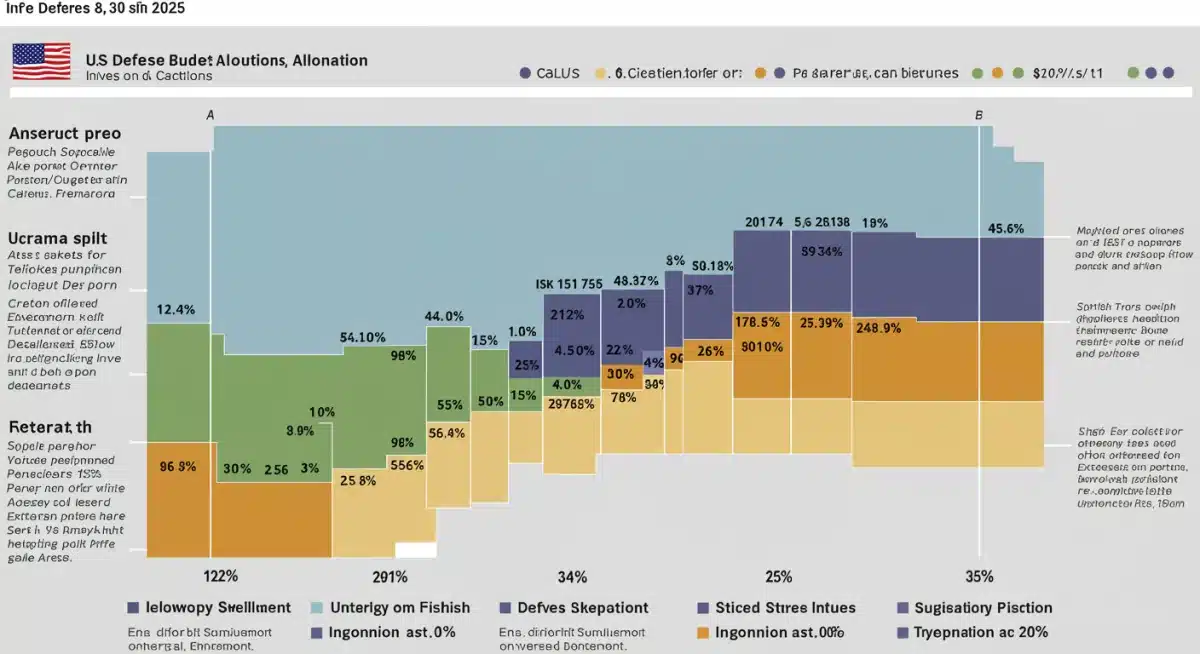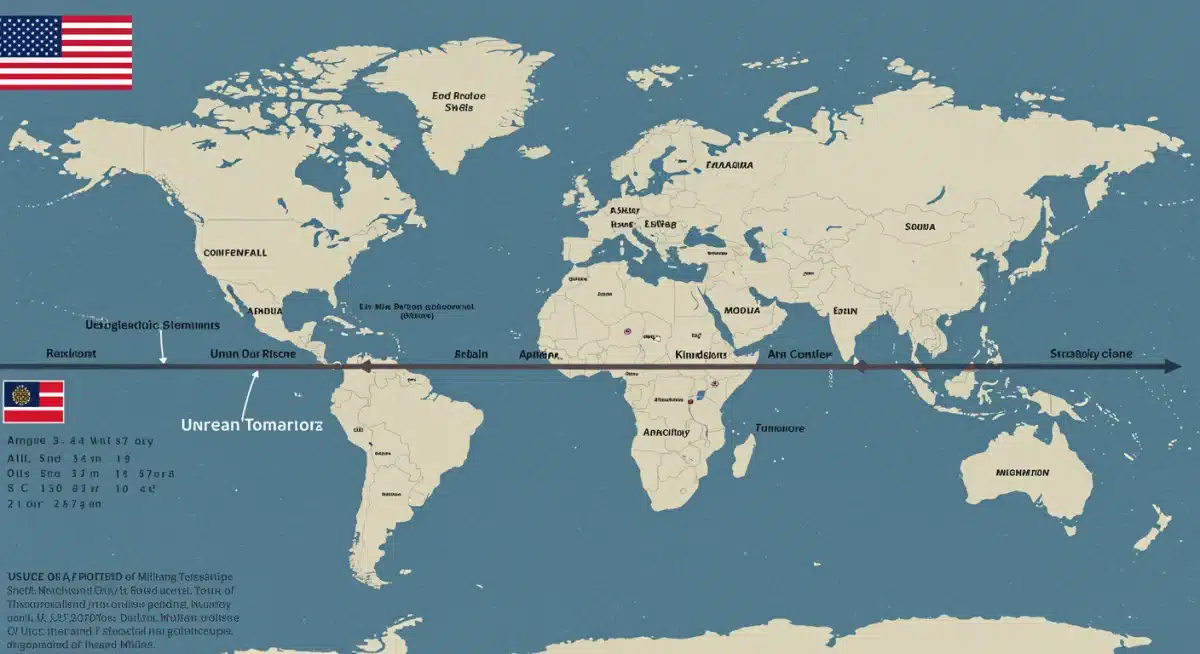Global Military Spending Surge: US Defense Strategy 2025

The significant 25% surge in global military spending directly impacts US defense strategy for 2025, necessitating re-evaluation of financial allocations, strategic priorities, and international partnerships amidst evolving geopolitical landscapes.
US Defense Spending 2025 is now a central topic as a striking 25% increase in global military expenditure reshapes international security dynamics. This unprecedented surge demands a thorough understanding of its financial implications, recent updates in policy, and how the United States plans to adapt its defense strategy, all critical for navigating an increasingly complex world.
The Unprecedented Rise in Global Military Spending
Global military spending has seen an alarming increase, reaching new heights that reflect a volatile geopolitical environment. This 25% rise, according to recent reports, is not merely an incremental adjustment but a significant shift, driven by ongoing conflicts, escalating regional tensions, and a renewed focus on national security by major powers. This substantial growth directly influences resource allocation and strategic planning worldwide.
The drivers behind this surge are multifaceted, encompassing both established and emerging threats. Nations are responding to perceived insecurities, modernizing their armed forces, and investing heavily in advanced military technologies. The ripple effects of this global trend are profound, especially for a nation with the strategic reach and responsibilities of the United States.
Key Drivers of the Spending Increase
- Geopolitical Instability: Ongoing conflicts in Eastern Europe and the Middle East, alongside heightened tensions in the Indo-Pacific, compel nations to bolster their defenses.
- Technological Race: The pursuit of advanced military capabilities, including AI, hypersonics, and cyber warfare tools, fuels significant research and development investments.
- National Security Prioritization: Governments are increasingly prioritizing defense budgets in response to a perceived decline in global stability and the rise of revisionist powers.
- Economic Power Shifts: Rising economic powers are translating their growth into military strength, challenging existing balances of power.
This confluence of factors creates a challenging landscape for policymakers. The decisions made today regarding military expenditure will undoubtedly shape the security environment for decades to come. Understanding these drivers is the first step in comprehending the broader implications for US Defense Spending 2025.
Financial Impact on US Defense Strategy in 2025
The global spending surge places immense pressure on the United States to recalibrate its own defense budget and strategic investments for 2025. As other nations increase their capabilities, the US must ensure its technological and operational superiority remains unchallenged. This means a careful balancing act between maintaining current readiness, investing in future technologies, and supporting allies.
The financial ramifications are extensive, impacting everything from procurement cycles to personnel costs. Defense planners are now faced with the task of optimizing every dollar to meet evolving threats without compromising domestic economic stability. The allocation of funds will reflect strategic priorities, emphasizing areas deemed most critical for national security and global stability.
Budgetary Reallocations and Investment Priorities
Anticipated budgetary shifts for 2025 indicate a clear focus on several key areas. The Department of Defense is expected to prioritize investments in advanced technologies, cybersecurity, and space-based capabilities. These areas are crucial for maintaining a competitive edge against near-peer adversaries and addressing asymmetric threats.
Furthermore, there will likely be increased funding for intelligence gathering and analysis, as well as for modernizing existing weapon systems. The goal is to create a more agile and resilient force capable of responding to a wide spectrum of challenges, from conventional warfare to hybrid threats. This also involves reviewing existing contracts and exploring new partnerships to leverage innovative solutions.
- Advanced Technology R&D: Significant boosts in funding for artificial intelligence, quantum computing, directed energy weapons, and hypersonics.
- Cybersecurity Enhancements: Increased investment in protecting critical infrastructure and military networks from sophisticated cyberattacks.
- Space Capabilities: Expansion of satellite networks and space-based defense systems to ensure dominance in the new frontier of warfare.
- Personnel Modernization: Funding for recruitment, training, and retention of highly skilled personnel essential for operating advanced systems.
The strategic financial decisions made in response to the global spending increase will define the US military’s posture and capabilities for the foreseeable future. These decisions are not made in a vacuum; they are a direct reaction to the dynamic international security landscape and the imperative to maintain peace through strength. The impact on US Defense Spending 2025 is therefore systemic.
Recent Updates and Policy Adjustments
In response to the escalating global military expenditures, the US government has already begun implementing several policy adjustments and strategic shifts. These updates reflect a proactive approach to maintaining deterrence and ensuring the nation’s security interests are protected. Key announcements and legislative actions highlight a renewed commitment to defense readiness and technological superiority.
Recent policy changes include increased collaboration with NATO allies, strengthening defense pacts in the Indo-Pacific, and a more aggressive stance on modernizing strategic nuclear forces. These actions are designed to project strength and reassure partners, while simultaneously signaling to potential adversaries that the US is prepared to defend its interests. The speed at which these updates are being rolled out underscores the urgency of the current global security situation.
Legislative Actions and Strategic Directives
Congress has passed several bills aimed at boosting defense capabilities and streamlining procurement processes. These legislative actions often include provisions for accelerated research and development, as well as increased funding for specific defense programs. The goal is to reduce bureaucratic hurdles and ensure that the military has access to the latest technologies as quickly as possible.
Furthermore, the Pentagon has issued new strategic directives that emphasize agile defense planning and diversified operational capabilities. These directives guide military branches in developing innovative tactics and strategies that can adapt to rapidly changing threat landscapes. The focus is on integrating new technologies seamlessly into existing frameworks and fostering a culture of continuous improvement.
- National Defense Authorization Act (NDAA): Recent NDAA iterations have increasingly focused on emerging threats and technological superiority, boosting funding for critical areas.
- Indo-Pacific Strategy: Enhanced military presence and exercises in the region, alongside strengthened alliances like AUKUS and the Quad, are central to counter regional challenges.
- NATO Reinforcement: Increased US contributions and troop deployments to European allies, reaffirming commitment to collective security in the face of aggression.
These policy adjustments are not merely theoretical; they translate into tangible changes in military operations, force structure, and international engagements. The ongoing updates are critical for shaping US Defense Spending 2025 and ensuring the nation remains a formidable force on the global stage. The dynamic nature of these changes requires continuous monitoring and adaptation.
Geopolitical Implications and Alliances
The 25% increase in global military spending has profound geopolitical implications, reshaping alliances and prompting a re-evaluation of international security frameworks. For the US, this means both challenges and opportunities. While the need for stronger alliances is apparent, the increased militarization globally also raises the specter of heightened tensions and potential conflicts.
The United States is actively engaging with its allies to coordinate responses to these new realities. Strengthening NATO, forging new partnerships in the Indo-Pacific, and participating in multilateral security dialogues are all part of a comprehensive strategy to manage the evolving geopolitical landscape. The goal is to create a network of deterrence that promotes stability and prevents aggression.
Strengthening Alliances and Partnerships
The role of alliances has never been more critical. The US is working closely with its traditional partners to share intelligence, conduct joint military exercises, and develop interoperable defense systems. This collaborative approach enhances collective security and ensures a unified response to common threats. New agreements and treaties are also being explored to expand the reach of these security networks.
In addition to traditional alliances, the US is also cultivating partnerships with emerging powers that share similar security concerns. These partnerships often involve technology transfers, joint training programs, and coordinated diplomatic efforts. The aim is to build a broader coalition of nations committed to upholding international law and promoting peaceful resolutions to disputes.

The global military spending surge underscores the imperative for robust and adaptable alliances. The US strategy for 2025 relies heavily on these partnerships to share the burden of defense and to present a united front against global challenges. This collaborative approach is central to the effectiveness of US Defense Spending 2025 and its broader strategic goals.
Technological Advancement and Modernization
The global surge in military spending is inextricably linked to a relentless pursuit of technological advancement and modernization. Nations are investing heavily in cutting-edge technologies to gain a decisive advantage on the battlefield. For the US, maintaining its technological lead is paramount, requiring continuous innovation and strategic investments in research and development.
The focus is on disruptive technologies that can redefine warfare, such as artificial intelligence, quantum computing, advanced robotics, and hypersonic weapons. These technologies promise to enhance surveillance, precision strike capabilities, and defensive measures. The competition to develop and deploy these systems is intense, driving significant portions of the increased global expenditure.
Investing in Future Warfare Capabilities
The US defense strategy for 2025 places a strong emphasis on integrating these advanced technologies into its armed forces. This involves not only developing new systems but also upgrading existing platforms and ensuring that military personnel are trained to operate them effectively. The goal is to create a future-ready force that can adapt to evolving threats and maintain superiority in all domains of warfare.
Specific areas of investment include cyber defense systems that can protect critical infrastructure, autonomous systems for reconnaissance and strike missions, and advanced materials for enhanced armor and stealth capabilities. The modernization effort also extends to logistics and supply chains, leveraging technology to improve efficiency and resilience. This comprehensive approach ensures that US Defense Spending 2025 yields a technologically superior military.
- Artificial Intelligence (AI): Development of AI-powered decision support systems, autonomous vehicles, and advanced cyber defense tools.
- Hypersonic Weapons: Investment in both offensive and defensive hypersonic capabilities to counter emerging threats.
- Quantum Technology: Research into quantum computing for cryptography, sensing, and secure communications.
- Cyber Warfare: Continuous development of offensive and defensive cyber capabilities to protect national interests and project power in the digital domain.
The race for technological supremacy is a defining feature of the current global security landscape. The US commitment to modernization and technological advancement is essential for maintaining its strategic advantage and ensuring the effectiveness of its defense strategy in 2025. This focus on innovation is a cornerstone of the response to increased global military spending.
Challenges and Opportunities for US Defense in 2025
The significant increase in global military spending presents both formidable challenges and unique opportunities for US defense strategy in 2025. Navigating this complex environment requires careful strategic planning, resource management, and diplomatic engagement. The challenges include managing fiscal constraints, adapting to new forms of warfare, and addressing the proliferation of advanced military technologies.
However, opportunities also arise, such as strengthening existing alliances, fostering innovation through public-private partnerships, and leveraging technological advancements to enhance deterrence. The ability of the US to capitalize on these opportunities while mitigating challenges will determine the efficacy of its defense posture in the coming years. This delicate balance is central to the discussions surrounding US Defense Spending 2025.
Addressing Fiscal Constraints and Strategic Adaptation
One of the primary challenges is balancing the need for increased defense spending with fiscal realities. The US must find ways to optimize its budget, eliminate inefficiencies, and ensure that every dollar spent contributes effectively to national security. This often involves difficult choices regarding program prioritization and resource allocation.
Strategic adaptation is another critical challenge. The nature of warfare is constantly evolving, with new domains like cyber and space becoming increasingly important. The US military must adapt its doctrines, training, and operational capabilities to effectively address these new dimensions of conflict. This requires a flexible and forward-thinking approach to defense planning.

Despite these challenges, there are significant opportunities. The global spending surge can spur innovation within the US defense industry, leading to advancements that benefit both military and civilian sectors. Furthermore, the increased focus on defense by allies can lead to stronger, more cohesive security partnerships, distributing the burden of global security more equitably. The effective management of these challenges and opportunities will be key to the success of US Defense Spending 2025 and its overarching strategy.
Key Point |
Brief Description |
|---|---|
Global Spending Surge |
A 25% increase in global military expenditure driven by geopolitical instability and technological race. |
US Financial Impact |
Recalibration of US defense budget, prioritizing advanced tech, cybersecurity, and space capabilities for 2025. |
Strategic Adjustments |
Policy shifts include strengthened alliances, increased NATO collaboration, and focus on Indo-Pacific security. |
Future Outlook |
Continued emphasis on technological superiority, agile defense planning, and robust international partnerships. |
Frequently Asked Questions on US Defense Spending 2025
▼
The increase is primarily driven by heightened geopolitical instability,
ongoing conflicts, a global technological arms race, and increased national
security prioritization by various nations seeking to bolster their
defenses against emerging threats.
▼
The US defense budget for 2025 will likely see reallocations towards
advanced technologies like AI, cybersecurity, and space capabilities to
maintain a competitive edge and ensure strategic superiority amidst global
militarization.
▼
Recent policy adjustments include strengthening alliances such as NATO,
enhancing defense partnerships in the Indo-Pacific, and modernizing
strategic forces, all aimed at projecting strength and ensuring collective
security.
2025?
▼
Technological advancements are crucial, with significant investments in
AI, hypersonics, quantum computing, and cyber warfare tools to maintain
the US military’s leading edge and adapt to future warfare domains.
▼
Challenges include fiscal constraints and adapting to new warfare types,
while opportunities lie in strengthening alliances, fostering innovation,
and leveraging technology for enhanced deterrence and global stability.
What this means
The 25% increase in global military spending signals a new era of strategic competition and heightened security concerns. For the United States, this necessitates a dynamic and adaptable defense strategy for 2025, one that prioritizes technological innovation, robust alliances, and prudent financial management. The trajectory of US Defense Spending 2025 will be a critical indicator of how the nation intends to navigate this complex global landscape, ensuring its security interests are protected while promoting stability in an increasingly volatile world. Future developments will likely focus on the implementation of these strategic shifts and their tangible impact on global power dynamics.





